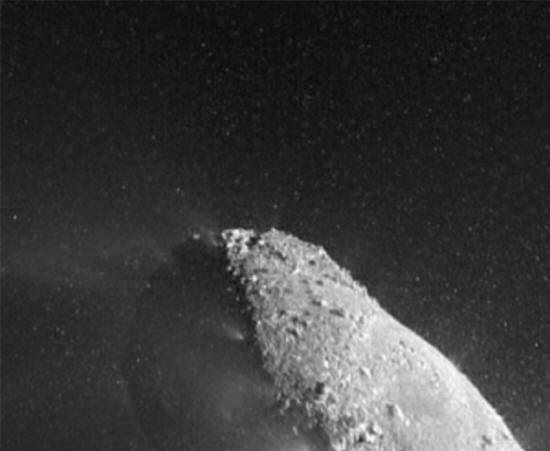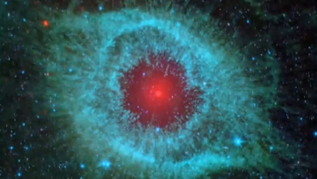|

Comet Hartley 2 supposedly
surrounded by "snowballs" of water
ice.
Credit: NASA/JPL-Caltech/UMD
Snowballs in Hell
Dec 27, 2010
Frozen clumps of ice are
thought to be spewing from the
nucleus of comet 103P/Hartley 2.
Comets are assumed to be icy
conglomerations of dust, gases, and
mineral grains from the earliest
days of the Solar System. As
many Picture of the Day
articles have argued, that
assumption leaves many puzzles
unexplained.
As early as
July 2004, Electric
Universe advocates have provided
analytical data that
contradicts the theory of
comet "snowballs." For example, some
comets demonstrate comas, tails, and
jets when they are far from the Sun,
supposedly the energy source for all
cometary activity. If the Sun is
what causes water ice to melt, or as
a recent
press release has
announced with some surprise, dry
ice (frozen carbon dioxide) to
sublime and form "jets," then a
comet past the orbit of Jupiter
should not exhibit those features.
Now, the EPOXI mission website
has stated that water ice has been
detected by the infrared camera
onboard the recommissioned Deep
Impact spacecraft. Despite some
differences between the spectrum of
pure water and the emissions from
Hartley 2,
NASA scientists state:
"Data collected by Deep Impact's
onboard infrared spectrometer show
without a doubt that the particles
are made of frozen H2O,
i.e., ice."
An electric comet hypothesis was
proposed by Ralph Juergens in
the early 1970's as a part of
his electric Sun model. His
physicist colleague, Dr. Earl
Milton, and Wal Thornhill
developed the model after
Juergens' untimely death in
1979. The first article on
electric comets on Thornhill's
website appeared in
October 2001 along with his
predictions for the Deep Impact
mission. Later articles appeared
in
January 2004 when the
Stardust mission encountered
comet Wild 2. And some results
of the Deep Impact experiment
were reported in
July 2005.As Thornhill writes: "The EU
model predicts that all active
comets will exhibit frequent, short
outbursts in different spots on
their surface. The outbursts happen
because they are electrical
discharge phenomena, known
technically as (cold) cathode jets.
Their onset will be as sudden as an
electric spark (described in one
report as 'nearly instantaneous')
and their duration extended only
because space plasma has a limited
current carrying capacity. The jets
will focus on an extremely small
bright area generally situated on a
raised point or edge of the comet
surface."
The cathode sparks erode minerals
from the surface of comets (such as
carbon) and, as Thornhill
elucidates, they can dissociate
comet minerals containing oxygen
atoms so that the ionized O- atom
combines with H+ ions, or protons,
from the Sun's solar wind, forming
the OH hydroxyl molecule. "It is an
assumption," Thornhill insists,
"that it is formed by the breakdown
of H2O 'vapor' by solar UV
radiation." The carbon from comet
minerals may similarly combine with
ionized oxygen to form carbon
monoxide in his electric comet
model.
Since comets are probably the
blasted out debris left over from
catastrophic events in the recent
past, then they are most likely
composed of many different
substances. In that scenario, there
could be comets in the Solar System
that are composed of water ice,
since ocean water could have also
been explosively launched into solar
orbit at the same time as the chunks
of rock. However, those water-based
objects have not been seen by space
borne imaging equipment.
As Wal Thornhill has made
abundantly clear, mission
specialists from the EPOXI team are
relying on assumptions to make their
observations fit. Comets that have
been lately investigated all appear
to be rocky bodies, lacking snow
fields or icy plains. Since they are
most likely stoney, then they could
be composed of silicon dioxide, as
well as several other mineral
compounds. If silicon is present,
then the cloud of large particles
could be small rocks with hydroxyl
coatings. Research
done in 1964 demonstrated
that the surfaces of silica gels can
contain hydroxyl groups.
Stephen Smith
Hat tip to Thane Hubbell
Multimedia

Debunking Misconceptions About
the Electric Universe
|








